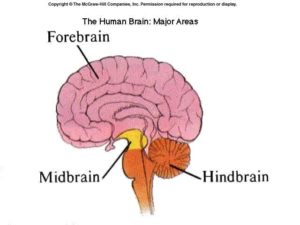Here’s a scenario parents of teens may be familiar with:
Your teen enters the kitchen. You ask them a question. Something innocent. The next thing you know, they erupt. They go into full meltdown mode, their anger off the charts. They yell and scream and slam doors. Maybe they end up crying.
You’re left wondering:
How did that escalate so quickly? What on earth just happened?
To answer that question, we need to give you a basic lesson on the anatomy of the human brain.
There are three major areas in the brain.

- Forebrain/Cortex. The forebrain contains the cortex and the prefrontal cortex, which is the executive function center of the brain. It regulates decision-making, planning, language, rational judgment, and impulse control. When we act in accordance with our values and filter our actions and thoughts in front of other people, we’re using our prefrontal cortex.
- Limbic System. The limbic system is sometimes called the midbrain or mammalian brain, because it’s responsible for “keeping track of the herd,” and keeping alert for social-emotional cues. It is also associated with vision, hearing, and temperature regulation. It’s located smack in the middle of the brain (hence its name) and sends signals between the forebrain and the hindbrain. The limbic system includes the amygdala, your personal alarm bell that tells you when something isn’t safe. The amygdala works hand in hand with the lower part of your brain stem to help you learn how to escape from stressful and dangerous situations.
- Hindbrain/Brainstem. The hindbrain controls the fight-flight-freeze response. That’s why the hindbrain is also called the animal brain: in evolutionary terms, the fight or flight reflex is one of the things that has kept both humans and animals alive for thousands of generations.
More About the Fight-Flight Response
Without the fight or flight response, animals wouldn’t survive. Imagine a prey animal strolling about on the savannah. It hears a noise in the branches behind it. Ears prick up: there’s a predator. The amygdala fires. The fight or flight reflex kicks in. The animal sprints away. An epic chase ensues. For the prey, it’s a matter of life and death.
In humans, this process is almost identical. When something stressful happens, our amygdala fires. Then, unless we have the skills in place to prevent it from happening, by default we automatically shift from our forebrain, which helps us with logical decision making and calm reason, to our animal brain, which causes the fight or flight response. This is why, when your teen does something to provoke you, your first thought might be to lash back (fight) or nervously shrink back and flee (flight). An hour or two later, you may regret your decision, because your forebrain has finally regained control of your thoughts and behavior.
Dr. Illyssa Bass, a child and adolescent psychologist, says people are “more prone to going to fight/flight mode when their nervous system is already under stress.” If the whole day was stressful and now it’s nighttime, or if we’re hungry or tired, we’re more likely to be triggered by our amygdala’s alarm bell. This why some days things are better with your teen and some days things are worse.
“On days their emotions are more regulated, your teen has more access to skills that help him manage stress,” Dr. Bass says. “On the other hand, emotional dysregulation shifts your teen to their animal brain.”
First Get Back to the Forebrain
Knowing this, you can understand why mental health professionals advise not to try and teach a teenager a new skill or lesson while they’re having a meltdown. When someone is in their emotional animal brain, they’re not thinking clearly or logically. They’re in fight-flight-freeze mode. Only after they shift d back to functioning in their forebrain should you start talking to them again.
In fact, the same applies to parents.
“Certain things will happen to you that may make your amygdala fire,” Dr. Bass says. “But you will never react appropriately when you yourself are functioning out of your animal brain. Even if your prefrontal cortex may be yelling at you to stop, it’s just an echoing sound. You’re not really listening to it.”
You’re literally not in the right state of mind.
So What Do You Do?
So, the solution when struggling with your teen?
First, regulate yourself. And then try to regulate your teen.
Okay, you’re thinking. Sounds simple.
But how in the world do you regulate yourself when you’re so mad?
The same way you expect your teen to.
To get back to your human brain – your forebrain – you need to calm down. And to calm down, you need emotion regulation and distress tolerance skills. Dialectical Behavior Therapy (DBT) is one excellent way anyone – teens and parents alike – can learn these skills.
DBT skills teach you how to reframe external stimuli that seem dangerous. You learn to recast the threats as facts, and then decide whether the stimuli is threatening or not. DBT skills also teach simple and practical ways to manage stressful emotions and experiences. Some DBT skills include going outside for some fresh air, splashing cold water on your face, listening to music, and checking the facts of a scenario to ensure sure you’re not catastrophizing. With these skills under your belt, you’ll be more prepared the next time your amygdala fires. Over time, you’ll be able to jump directly from the animal brain (fight-flight reflex) to the forebrain (calm reasoning) in a matter of seconds.
Your teen can learn these stress-response skills when they receive treatment at an intensive outpatient program (IOP), partial hospitalization program (PHP), or residential treatment center (RTC) that specializes in DBT Skills for adolescents.































































